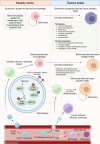Macrophages in immunoregulation and therapeutics
- PMID: 37211559
- PMCID: PMC10200802
- DOI: 10.1038/s41392-023-01452-1
Macrophages in immunoregulation and therapeutics
Abstract
Macrophages exist in various tissues, several body cavities, and around mucosal surfaces and are a vital part of the innate immune system for host defense against many pathogens and cancers. Macrophages possess binary M1/M2 macrophage polarization settings, which perform a central role in an array of immune tasks via intrinsic signal cascades and, therefore, must be precisely regulated. Many crucial questions about macrophage signaling and immune modulation are yet to be uncovered. In addition, the clinical importance of tumor-associated macrophages is becoming more widely recognized as significant progress has been made in understanding their biology. Moreover, they are an integral part of the tumor microenvironment, playing a part in the regulation of a wide variety of processes including angiogenesis, extracellular matrix transformation, cancer cell proliferation, metastasis, immunosuppression, and resistance to chemotherapeutic and checkpoint blockade immunotherapies. Herein, we discuss immune regulation in macrophage polarization and signaling, mechanical stresses and modulation, metabolic signaling pathways, mitochondrial and transcriptional, and epigenetic regulation. Furthermore, we have broadly extended the understanding of macrophages in extracellular traps and the essential roles of autophagy and aging in regulating macrophage functions. Moreover, we discussed recent advances in macrophages-mediated immune regulation of autoimmune diseases and tumorigenesis. Lastly, we discussed targeted macrophage therapy to portray prospective targets for therapeutic strategies in health and diseases.
© 2023. The Author(s).
Conflict of interest statement
The authors declare no competing interests.
Figures




References
Publication types
MeSH terms
LinkOut - more resources
Full Text Sources
Medical

